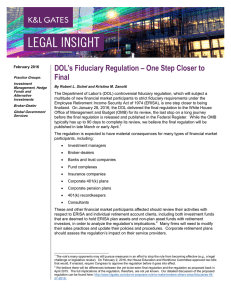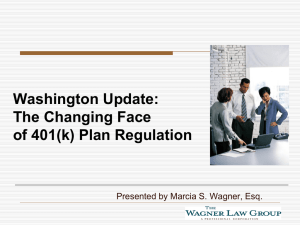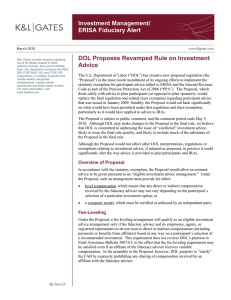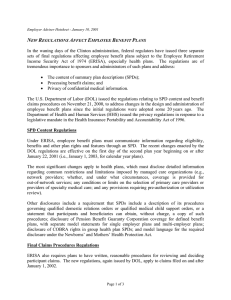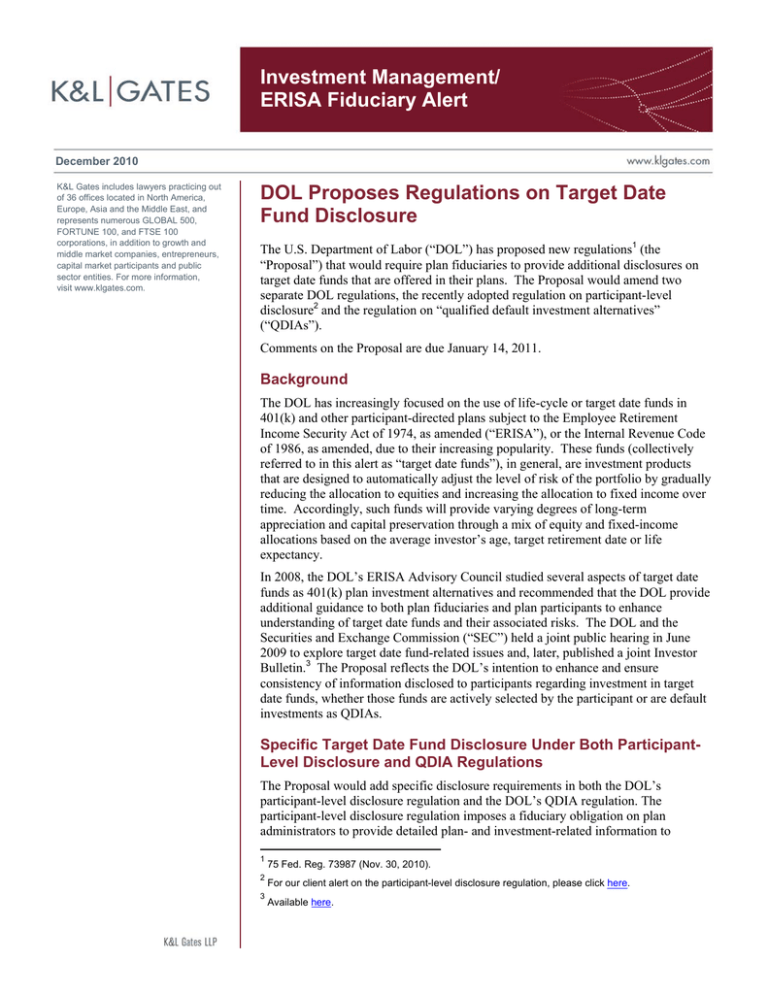
Investment Management/
ERISA Fiduciary Alert
December 2010
K&L Gates includes lawyers practicing out
of 36 offices located in North America,
Europe, Asia and the Middle East, and
represents numerous GLOBAL 500,
FORTUNE 100, and FTSE 100
corporations, in addition to growth and
middle market companies, entrepreneurs,
capital market participants and public
sector entities. For more information,
visit www.klgates.com.
DOL Proposes Regulations on Target Date
Fund Disclosure
The U.S. Department of Labor (“DOL”) has proposed new regulations1 (the
“Proposal”) that would require plan fiduciaries to provide additional disclosures on
target date funds that are offered in their plans. The Proposal would amend two
separate DOL regulations, the recently adopted regulation on participant-level
disclosure2 and the regulation on “qualified default investment alternatives”
(“QDIAs”).
Comments on the Proposal are due January 14, 2011.
Background
The DOL has increasingly focused on the use of life-cycle or target date funds in
401(k) and other participant-directed plans subject to the Employee Retirement
Income Security Act of 1974, as amended (“ERISA”), or the Internal Revenue Code
of 1986, as amended, due to their increasing popularity. These funds (collectively
referred to in this alert as “target date funds”), in general, are investment products
that are designed to automatically adjust the level of risk of the portfolio by gradually
reducing the allocation to equities and increasing the allocation to fixed income over
time. Accordingly, such funds will provide varying degrees of long-term
appreciation and capital preservation through a mix of equity and fixed-income
allocations based on the average investor’s age, target retirement date or life
expectancy.
In 2008, the DOL’s ERISA Advisory Council studied several aspects of target date
funds as 401(k) plan investment alternatives and recommended that the DOL provide
additional guidance to both plan fiduciaries and plan participants to enhance
understanding of target date funds and their associated risks. The DOL and the
Securities and Exchange Commission (“SEC”) held a joint public hearing in June
2009 to explore target date fund-related issues and, later, published a joint Investor
Bulletin.3 The Proposal reflects the DOL’s intention to enhance and ensure
consistency of information disclosed to participants regarding investment in target
date funds, whether those funds are actively selected by the participant or are default
investments as QDIAs.
Specific Target Date Fund Disclosure Under Both ParticipantLevel Disclosure and QDIA Regulations
The Proposal would add specific disclosure requirements in both the DOL’s
participant-level disclosure regulation and the DOL’s QDIA regulation. The
participant-level disclosure regulation imposes a fiduciary obligation on plan
administrators to provide detailed plan- and investment-related information to
1
2
3
75 Fed. Reg. 73987 (Nov. 30, 2010).
For our client alert on the participant-level disclosure regulation, please click here.
Available here.
Investment Management/ERISA Fiduciary Alert
participants, particularly the fees and expenses paid
by participants for the investment of participant
accounts and the administration of the plan. The
QDIA regulation, which specifically includes target
date funds as a type of QDIA, limits the liability of
fiduciaries that default the assets of a participant into
a QDIA.
date fund, the Proposal also would conform
investment-related information that must be
disclosed under the QDIA regulation to the
information that must be disclosed under the
participant-level disclosure regulation. Under the
Proposal, a fiduciary would be required to provide
participants with the following information:
Under the Proposal, a plan fiduciary4 would be
required to furnish each participant the following
information for each target date fund available under
the plan:
A. A description of the QDIA including:
A. an explanation of the target date fund’s asset
allocation, how the asset allocation will change
over time, and the target asset allocation at the
time the fund will reach its most conservative
asset allocation, including a clarifying chart,
table, or other graphical representation that
illustrates such change in asset allocation over
time (i.e., the target date fund’s “glidepath”);
B. if the target date fund is named or otherwise
described with a reference to a particular date
(for example, a “2040” fund), an explanation of
the age group for whom the investment is
designed, the relevance of the date, and any
assumptions about a participant’s contribution
and withdrawal intentions on or after such date;
and
C. if applicable, a statement that the participant
may lose money by investing in the target date
fund, including losses near and following
retirement, and that there is no guarantee that the
investment will provide adequate retirement
income.
In the case of the participant-level disclosure
regulation, this information would be required to be
included as an appendix or appendices to the
comparative chart or similar document otherwise
required under that regulation.
Additional Amendments to the QDIA
Regulation
For all QDIAs, whether or not the QDIA is a target
4
Specifically the “plan administrator” in the case of the
participant-level disclosure regulation.
1. the name of the QDIA;
2. the QDIA’s investment objectives or goals;
3. the QDIA’s principal strategies (including a
general description of the types of assets
held by the QDIA) and principal risks;
4. the QDIA’s historical performance data and
a statement indicating that an investment’s
past performance is not necessarily an
indication of future results and, if
applicable, a description of any fixed
return, annuity, guarantee, death benefit, or
other ancillary features; and
5. the QDIA’s attendant fees and expenses,
including: (A) any fees charged directly
against the amount invested in connection
with acquisition, sale, transfer of, or
withdrawal (e.g., commissions, sales loads
or charges, redemption fees, surrender
charges, exchange fees, account fees, and
purchase fees), (B) any annual operating
expenses (e.g., the expense ratio), and (C)
any ongoing expenses in addition to the
annual operating expenses (e.g., mortality
and expense fees).
B. A description of the right of the participants
whose accounts are invested by default in a
QDIA to direct the investment of those assets to
any other investment option available under the
plan and, if applicable, a statement that certain
fees and limitations may apply in connection
with such transfer.
C. An explanation of where the participants can
obtain additional investment information
concerning the QDIA and other investment
alternatives available under the plan.
December 2010
2
Investment Management/ERISA Fiduciary Alert
D. Any materials provided to the plan relating to
the exercise of voting, tender, and similar rights
appurtenant to the QDIA, to the extent such
rights are passed through to such participant.
E. Upon request,
1. copies of the QDIA’s prospectus (or any
short-form or summary prospectus whose
form has been approved by the SEC) or any
similar documents.
2. copies of financial statements or reports,
such as statements of additional information
or shareholder reports, and any other similar
materials related to the QDIA, if such
materials are provided to the plan.
3. a statement of the value of a share or unit of
an investment in the QDIA, and the date of
such valuation.
4. a list of the assets comprising the portfolio
of the QDIA and the value of each such
asset (or the proportion of the QDIA which
it comprises).
Observations
In some respects, the Proposal is an unsurprising
outgrowth of the DOL’s rule-making over recent
years that seeks to enhance transparency and
understanding by plan fiduciaries and participants of
investment products available to them and to do so
through more uniform disclosures. As noted above,
the Proposal would impose the new disclosure
obligations on plan fiduciaries. As with the
participant-level disclosure requirements, it is likely
that plan fiduciaries will look to third-party
investment product sponsors for the requisite target
date fund disclosures. Significantly, however, the
Proposal’s changes to the QDIA regulation do not
include the explicit safe harbor for reliance on
information provided by a third party that is
provided in the participant-level disclosure
regulation.
As the DOL notes in the preamble to the Proposal, it
has coordinated to some extent with the SEC with
respect to its inquiries and proposed requirements as
to target date funds. In June 2010, the SEC
proposed new disclosure requirements for mutual
fund advertising for target date funds. These
proposed SEC rules have not been finalized. If and
when they are, it remains to be seen to what extent
the disclosures under these rules will be consistent
with those required under the Proposal.
*
*
*
Please contact any member of the ERISA Fiduciary
Group listed below if you have further questions.
Catherine S. Bardsley
catherine.bardsley@klgates.com
202-778-9289
Mark J. Duggan
mark.duggan@klgates.com
617-261-3156
John J. Nestico
john.nestico@klgates.com
704-331-7529
David E. Pickle
david.pickle@klgates.com
202-778-9887
William A. Schmidt
william.schmidt@klgates.com
202-778-9373
William P. Wade
william.wade@klgates.com
310-552-5071
Kristina M. Zanotti
kristina.zanotti@klgates.com
202-778-9171
December 2010
3
Investment Management/ERISA Fiduciary Alert
Anchorage Austin Beijing Berlin Boston Charlotte Chicago Dallas Dubai Fort Worth Frankfurt Harrisburg Hong Kong London
Los Angeles Miami Moscow Newark New York Orange County Palo Alto Paris Pittsburgh Portland Raleigh Research Triangle Park
San Diego San Francisco Seattle Shanghai Singapore Spokane/Coeur d’Alene Taipei Tokyo Warsaw
Washington, D.C.
K&L Gates includes lawyers practicing out of 36 offices located in North America, Europe, Asia and the Middle East, and represents numerous
GLOBAL 500, FORTUNE 100, and FTSE 100 corporations, in addition to growth and middle market companies, entrepreneurs, capital market
participants and public sector entities. For more information, visit www.klgates.com.
K&L Gates comprises multiple affiliated entities: a limited liability partnership with the full name K&L Gates LLP qualified in Delaware and
maintaining offices throughout the United States, in Berlin and Frankfurt, Germany, in Beijing (K&L Gates LLP Beijing Representative Office), in
Dubai, U.A.E., in Shanghai (K&L Gates LLP Shanghai Representative Office), in Tokyo, and in Singapore; a limited liability partnership (also named
K&L Gates LLP) incorporated in England and maintaining offices in London and Paris; a Taiwan general partnership (K&L Gates) maintaining an
office in Taipei; a Hong Kong general partnership (K&L Gates, Solicitors) maintaining an office in Hong Kong; a Polish limited partnership (K&L
Gates Jamka sp.k.) maintaining an office in Warsaw; and a Delaware limited liability company (K&L Gates Holdings, LLC) maintaining an office in
Moscow. K&L Gates maintains appropriate registrations in the jurisdictions in which its offices are located. A list of the partners or members in each
entity is available for inspection at any K&L Gates office.
This publication is for informational purposes and does not contain or convey legal advice. The information herein should not be used or relied upon
in regard to any particular facts or circumstances without first consulting a lawyer.
©2010 K&L Gates LLP. All Rights Reserved.
December 2010
4


